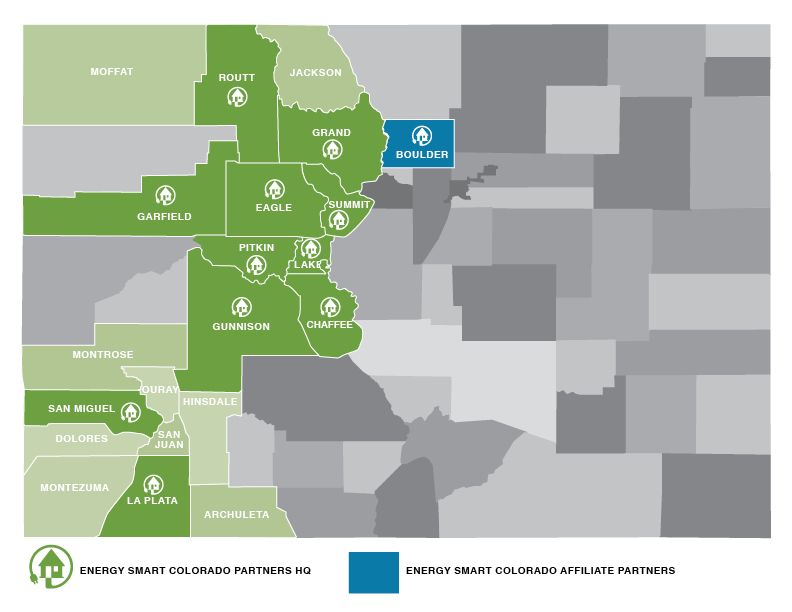Janice Godard, Breckenridge
Written by tschalow on . Posted in Blog, Success Stories.
Janice Godard
Wellington neighborhood homeowner Janice Godard obtained her college degree in sustainable management so it was an easy decision to sign up for a home energy assessment with Energy Smart Colorado.
Assessment Process & Findings
Janice noted that her kitchen always tended to be cold – even in summer months. During the assessment, local analyst Mark Anderson performed a blower door test which simulates a 20 mph wind hitting all sides of the house by sucking air out of the house.
During the blower door test, the building analyst found the home to be VERY leaky. 93% of the air in the home was being exchanged every hour with outside air. With the help of an infrared camera, Mark found significant air leaks around the attic hatch, recessed lighting, “mystery” vents in the top floor bedrooms, around the front door and bath vents as well as all exterior wall outlets and switches, baseboards, and the plumbing chase. Additionally, large areas of the attic and the home’s crawlspace were found to be missing insulation.
Measures Completed
With a contractor list provided by High Country Conservation Center in hand, Janice employed a local contractor to caulk and provide air sealing measures, as well as improve the insulation in the lowest and highest levels of the home.
“The Energy Smart program is an excellent opportunity. My analyst was super easy to work with, and the whole process was painless.”
– Janice Godard, Breckenridge
Project Costs
With rebates from High Country Conservation Center, $400 was knocked off the $1,764 crawlspace insulation costs.
Energy Efficiency Savings
With an annual savings estimated at $365, Janice’s after-rebate cost of $1,364 will payback in less than four years.
More Success Stories
Bowes/Weight Family, Dillon
Written by tschalow on . Posted in Blog, Success Stories.
Bowes & Weight Family
High utility costs, freezing pipes and comfort concerns prompted Margaret and Richard to reach out to Energy Smart to learn more about how their all-electric home used energy. Built in the late 70’s, the home was constructed prior to today’s building codes that tend to consider a home’s potential energy efficiency.
Assessment Process & Findings
During the home energy assessment, a local analyst performed blower door testing and used an infrared camera to identify air leakage. Through the assessment process, the contractor observed significant air leakage throughout the two-story home. The home’s building design, with large windows and cantilevers on the north and east sides of the home, in combination with poor attic insulation was creating significant heat loss. The home’s clothes dryer and a bathroom fan were venting to the crawlspace and the roof cavity, respectively, causing potential for mold and contributing to the cold air entering the home. Several photos included in the audit report showed dramatic holes around wiring and piping that were sending heat directly to the outdoors. With the 15-page assessment report in hand, the owners tackled each of the analyst’s recommendations over the next several years.
Measures Completed by Homeowners
- Encapsulated vertical knee wall in attic
- Insulated attic door hatch and added strong latch
- Replaced soffit board (which was vented) under shed roof and added insulation
- Added spray foam to gaps around plumbing and wiring pentrations
- Vented a bath exhaust fan and clothes dryer to outside
- Replaced dining room sliding glass door
- Adding ceiling fan to upstairs bedroom
Measures Completed by Local Contractors
- Added R40 blown insulation on top of existing R23 insulation in attic
- Insulated two cantilevered floors with closed cell R54 rigid polyurethane foam
- Insulated crawlspace with closed cell R24 rigid polyurethane foam
“One of our guests used to pack warm clothing to stay our house. Seriously, it felt that cold! Once we learned (from the energy assessment) where our home was losing heat, we were able to address many of the issues ourselves. After several relatively inexpensive energy efficiency improvements, the warmth and comfort of our home noticeably improved. The dramatically lower energy bills presented another bonus to us.”
– Margaret Bowes, Dillon
Project Costs
Over five years, the homeowners invested roughly $3,200 in energy efficiency improvements. More than $1,000 in rebates awarded from High County Conservation Center, the State of Colorado and Xcel Energy covered 1/3 of their costs.
Energy Efficiency Savings
Following the upgrades, the analyst returned to perform another blower test for the homeowners. The “post” blower door test revealed a 33% reduction in air changes in the home. The resulting utility bills though spoke for themselves.
The energy efficiency improvements produced a household savings of 40% on energy and utility costs:
Baseline of home’s energy use:
22,757 kWh annually
After energy efficiency improvements were completed:
14,109 kWh annually
More Success Stories
Lara Whitley, Aspen
Written by tschalow on . Posted in Blog, Success Stories.

Lara Whitley
Sixteen days into my marketing gig at CORE, I was signing up for a home energy assessment. I figured first-hand experience was a must if I was going to be touting the assessment — a foundation of CORE’s energy-efficiency gospel. Plus, I wanted to know exactly how easy, or not, it would actually be to lower our carbon footprint. And how quick we could get some of those dreamy solar panels installed on our roof.
Here’s what we learned after we got a home energy assessment.
1. Our Biggest Priority Was Invisible to Us.
We found out that our house earned an air exchange rating that put us on the “very leaky home” end of the spectrum. This data helped us single out our most effective next steps: air sealing and insulation, things that we wouldn’t have been able to see otherwise. Not as sexy as solar, but surprisingly rewarding. Why? We got immediate feedback on the effectiveness when we couldn’t start a fire in our wood stove — a sign that our house was now so tight that we didn’t have ANY drafts. Wow.
2. Cozy + Savings = Awesome.
Cold spots were banished and our house was notably cozier. Suddenly everyone was hanging out in the living room. This was backed up by a 20% reduction on our gas bill.
3. You Don’t Know What You Don’t Know. And That Can Be Dangerous.
We got the “all clear” on carbon monoxide and gas leaks, but found out that we were on the bubble for radon levels. The results keyed us to go back in with more sophisticated testing. The peace of mind on our family’s health and safety can’t be understated.
4. CORE Rebates Made It Easier to Do the Right Thing.
Home energy improvements can be spendy. The home energy assessment qualified us for CORE’s cash-back rebates to the tune of $1,000. These helped us to make sustainable choices that we might not have been able to otherwise, aligning our home with our values.
5. Solar Is Sexy, but That Doesn’t Mean It Comes First.
In fact, it probably shouldn’t. With our home energy assessment, we received advising on the basics of creating a clean energy future at home:
First, get lean. Do everything you can to make your home hum as efficiently as possible.
Then, find your baselines. Your energy-efficiency efforts will determine the minimum energy you need to power your home.
Next, go renewable. With this data, you can start replacing your coal-powered energy with renewables like solar.
Written by: Lara Whitley, Former Brand + Creative Strategy Director, Community Office for Resource Efficiency
Photo credit: Michele Cardamone Photography
Measures Taken
- Air sealing & insulation
- Radon testing
Program Benefits
In the end, the home energy assessment has become a journey, rather than mere marketing research, or something to check off my list in my rush to bright and shiny PV panels. I received far more than I bargained for: knowledge, comfort, peace of mind, a healthier home, cash in our pocket, and a roadmap to a low-carbon future. Those are their own rewards, but I also sleep well knowing our home is optimized for efficiency.
More Success Stories
CHRISTINE BERG
Written by tschalow on . Posted in Blog.
As the Senior Policy Advisor for Local Government at the Colorado Energy Office, Christine provides resources to cities and counties to meet their climate and energy goals. Prior to her position with the state, she worked in environmental advocacy and served as the mayor of Lafayette. She led efforts to establish Lafayette’s climate action goals; using 100% renewable energy by 2030 and an 80% reduction in greenhouse gas emissions by 2050. During her tenure, the City of Lafayette received the Xcel Energy Sustainability Commitment Award for outstanding leadership in sustainability and commitment to energy efficiency and renewable energy. She lives with her family in Lafayette including her husband Zak, her girls Sunny and Lumina, and her rescue dog Conan.




